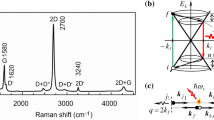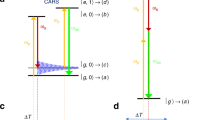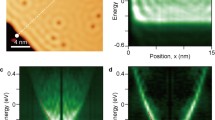Abstract
The mechanism of resonant light scattering in single-layer graphene is discussed. A new concept of electron–hole self-photorecombination is proposed, which makes it possible to clearly separate the phenomena of resonant light scattering and resonant photoluminescence. It is established that Rayleigh resonant radiation has been found to consist of virtual and non-virtual components. It has been shown that Rayleigh radiation is mainly caused by resonant non-virtual optical transitions. The band of Rayleigh radiation due to resonant virtual transitions is quite wide, and the intensity is extremely low. On the basis of the presented theory, the results of numerical estimates of the linewidth and intensity of the Rayleigh band of single-layer graphene are in fairly good agreement with the experimental data.




Similar content being viewed by others
Data availability
All data gathered or analyzed during this study are included in this study article.
References
Yoon D, Moon H, Cheong H (2009) Variations in the Raman spectrum as a function of the number of graphene layers. J Korean Phys Soc 55(3):1299–1303. https://doi.org/10.3938/jkps.55.1299
Cong C, Yu T, Saito R, Dresselhaus GF, Dresselhaus MS (2011) Second-order overtone and combination Raman modes of graphene layers in the range of 1690–2150 cm−1. ACM Nano 5(3):1600–1605. https://doi.org/10.1021/nn200010m
Ferreira EHM, Moutinho MVO, Stavale F, Lucchese MM, Capaz RB, Achete CA, Jorio A (2010) Evolution of the Raman spectra from single-, few- and many-layer graphene with increasing disorder. Phys Rev. https://doi.org/10.1103/PhysRevB.82.125429
Rodriguez-Nivea JF, Saito R, Costa SD, Dresselhaus MS (2012) Effect of 13C isotope doping on the optical phonon modes in graphene: localization and Raman spectroscopy. Phys Rev B 85:245406-1–245406-8. https://doi.org/10.1103/PhysRevB.85.245406
Kumar V, Kumar A, Lee D-J, Park S-S (2021) Estimation of number of graphene layers using different methods: a focused review. Materials 14(16):4590. https://doi.org/10.3390/ma14164590
Bruna M, Ott AK, Ijas M, Yoon D, Sassi U, Ferrari AC (2014) Doping dependence of the Raman spectrum of defected graphene. ACS Nano 8(7):7432–7441. https://doi.org/10.1021/nn502676g
Ferrari AC (2007) Raman spectroscopy of graphene and graphite: disorder, electron–phonon coupling, doping and nonadiabatic effects. Solid State Commun 143:47–57. https://doi.org/10.1016/j.ssc.2007.03.052
Saito R, Hofmann M, Dresselhaus G, Jorio A, Dresselhaus MS (2011) Raman spectroscopy of graphene and carbon nanotubes. Adv Phys 60(3):413–550. https://doi.org/10.1080/00018732.2011.582251
Ferrari AC, Basko DM (2013) Raman spectroscopy as a versatile tool for studying the properties of graphene. Nat Nanotechnol 8:235–246. https://doi.org/10.1038/NNANO.2013.46
Beams R, Cancado LG, Novotny L (2015) Raman characterization of defects and dopants in graphene. J Phys Condens Matter. https://doi.org/10.1088/0953-8984/27/8/083002
Wu J-B, Lin M-L, Cong X, Liua H-N, Tan P-H (2018) Raman spectroscopy of graphene-based materials and its applications in related devices. Chem Soc Rev 47:1822–1873. https://doi.org/10.1039/c6cs00915h
Jiang J, Pachter R, Mehmood F, Islam AE, Maruyama B, Boeckl JJ (2015) A Raman spectroscopy signature for characterizing defective single-layer graphene: defect-induced I(D)/I(D’) intensity ratio by theoretical analysis. Carbon 90:53–62. https://doi.org/10.1016/j.carbon.2015.03.049
Jorio A, Dresselhaus MS, Saito R, Dresselhaus G (2011) Raman Spectroscopy in Craphene Related Systems. John Wiley & Sons, Singapore
Basko DM (2008) Theory of resonant multiphonon Raman scattering in graphene. Phys Rev B 78:125418-1–125418-42. https://doi.org/10.1103/PhysRevB.78.125418
Venezuela P, Lazzeri M, Mauri F (2011) Theory of double-resonant Raman spectra in graphene: intensity and defect-induced and two-phonon dands. Phys Rev B 84:035433-1–035433-25. https://doi.org/10.1103/PhysRevB.84.035433
Heller EJ, Yang Y, Kocia L, Chen W, Fang S, Borunda M, Kaxiras E (2016) Theory of Graphene Raman scattering. ACS Nano 10(2):2803–2818. https://doi.org/10.1021/acsnano.5b07676
Hong J, Park MK, Lee EJ, Lee DE, Hwang DS, Ryu S (2013) Origin of new broad Raman D and G peaks in annealed graphene. Sci Rep 3(2700):1–5. https://doi.org/10.1038/srep02700
Casiraghi C, Harstschuh A, Lidorikis E, Qian H, Harutyunyan H, Gokus T, Novoselov KS, Ferrari AC (2007) Rayleigh imaging of graphene and graphene layers. Nano Lett 7(9):2711–2717. https://doi.org/10.1021/nl071168m
Davydov AS (1976) Solid state theory, Russian. Nauka, Moscow
Melkonyan SV (2021) Coulomb mechanism of Raman radiation in graphene. Carbon Letters 31(5):1051–1059. https://doi.org/10.1007/s42823-020-00220-3
Anselm AI (1981) Introduction to semiconductor theory. Mir Pub, Moscow
Fitzpatrick R (2015) Quantum mechanics. World Scientific Publishing Co. Pte. Ltd., Singapure
Stauber T, Peres NMR, Guinea F (2007) Electronic transport in graphene: a semi-classical approach including midgap states. Phys Rev B 76:205423-1–205423-10. https://doi.org/10.1103/PhysRevB.76.205423
Hwang EH, Sarma SD (2008) Acoustic phonon scattering limited carrier mobility in 2D extrinsic Graphene. Phys Rev B 77:115449-1–115449-6. https://doi.org/10.1103/PhysRevB.77.115449
Perebeinos V, Avouris P (2010) Inelastic scattering and current saturation in graphene. Phys Rev B 81:195442-1–195442-8. https://doi.org/10.1103/PhysRevB.81.195442
Shishir RS, Ferry DK (2009) Intrinsic mobility in graphene. J Phys Condens Matter 21:232204. https://doi.org/10.1088/0953-8984/21/23/232204
Author information
Authors and Affiliations
Corresponding author
Ethics declarations
Conflict of interest
All authors declare that they have no conflicts of interest.
Additional information
Publisher's Note
Springer Nature remains neutral with regard to jurisdictional claims in published maps and institutional affiliations.
Rights and permissions
Springer Nature or its licensor (e.g. a society or other partner) holds exclusive rights to this article under a publishing agreement with the author(s) or other rightsholder(s); author self-archiving of the accepted manuscript version of this article is solely governed by the terms of such publishing agreement and applicable law.
About this article
Cite this article
Melkonyan, S.V., Zalinyan, T.A. Basic principles of resonance Rayleigh scattering in Graphene. Carbon Lett. 33, 1783–1789 (2023). https://doi.org/10.1007/s42823-023-00569-1
Received:
Revised:
Accepted:
Published:
Issue Date:
DOI: https://doi.org/10.1007/s42823-023-00569-1




